This article was co-authored by Anthony Stark, EMR. Anthony Stark is a certified EMR (Emergency Medical Responder) in British Columbia, Canada. With over 11 years of experience, he has worked as an industrial medic and provided urban and rural paramedic services. He currently works for Mountain View Safety Services and previously worked for the British Columbia Ambulance Service. Anthony has a Bachelor of Engineering in Electrical, Electronics, and Communications Engineering from the Georgia Institute of Technology. He has completed the EMP Canada EMT Course and Swiftwater Awareness Training associated with the British Columbia Ambulance Service.
This article has been viewed 149,658 times.
If you find yourself in an emergency situation where someone collapses or you find someone passed out, you need to check to see if he needs CPR. CPR is a life saving technique, but should only be performed if someone is truly in need of it. In order to check if the person needs CPR, you must check the airways, breathing, and circulation before you begin.
Steps
Checking Responsiveness
-
1Assess the situation. When you find someone collapsed or you witness someone pass out, look around and figure out if you can reach him without putting your own safety at risk. You also need to see if he is in an area big enough for you to move around and help. If the person looks like he is in immediate danger (such as the middle of a street), try to move him to a safe location before you attempt to help him — but do not put yourself in harm's way. If you rush into a dangerous situation, you may also end up injured. Not only does this not help the person you were trying to save, it also gives emergency personnel yet another person to rescue.
- Use caution if there is presumed potential neck or spinal injury, such as a person who has fallen from a height or at the scene of an automobile accident where there are signs of additional obvious major trauma.[1] Anyone who has fallen from a height or been involved in an motor vehicle accident should have spinal precautions taken.
-
2Talk to the victim. One of the best ways to check to see if a person is responsive is to talk to him. Ask questions like, "What is your name?", "Are you alright?", and "Can you hear me?" These questions may rouse the victim from whatever haze she is in and make her respond. Also tap her shoulder or arm while you do it to see if that will help as well.
- If this doesn't work, try yelling once or twice at her to see if that will rouse her. Yell phrases such as "Hey!" or "Hello!" to see if she wakes up.[2]
Advertisement -
3Perform a sternal rub. A sternal rub may help you to establish that the person is indeed unresponsive. You don't want to do CPR on someone who is just poorly responsive but still breathing and circulating blood. Make a fist and rub your knuckles hard on the person’s breastbone.
- You can also try a "trap squeeze," which is when you grasp the muscles of the shoulder by your thumb and fingers and squeeze into the hollow of the collarbone. Bend low as you do this and listen for sounds or signs of breathing.
- Anyone who is simply sedated but breathing should rouse from the pain.[3]
- Note the reaction, if any, to tell to EMS when they arrive.
Checking the Airways
-
1Position the victim. Before you can check the airway, the victim needs to be in the right position. If there is any exudate (vomit, blood, etc.) in or around the person's mouth, put on a glove and remove it to clear the airway before you roll her. Roll the person onto her back. This should be on a surface as flat as possible so her body can be straight and easy to work with. Make sure his hands are down by his sides and his back and legs are straight.[4]
- Take a moment to push her shoulders down gently. This expands the width of the trachea and helps to keep the jaw lifted.
-
2Move the head. To open the airway when he is laying on the ground, his head and breathing passages need to be aligned correctly. Place one hand behind his head and one hand under his chin. Tilt his head backward toward the sky.
- The chin should end in a slightly lifted position, as if he were sniffing the air.[5]
-
3Remove foreign objects from the airway. There may be situations where the airway is obstructed. This may be from a foreign object, by the victim's tongue, or by vomit or other bodily fluids. If the airway is obviously obstructed by vomit or any removable matter, get it out of the mouth with a quick swipes with two or three fingers in her mouth. You can quickly turn the victim’s head to one side to assist in the removal.
- Try to avoid pushing any matter further down the trachea by only sweeping as far as you can easily see inside the open mouth. Use sweeping motions rather than digging ones.
- If the tongue is obstructing the airway, try the jaw thrust method. Crouch above her head, looking down toward the toes. Grasp the jaw gently but firmly with both hands, so that you can curve your fingers into the soft flesh of the chin. Gently lift the jaw to the sky without moving the rest of the head. This helps the tongue to fall to the floor of the jaw, rather than settling in the airway.
Checking for Breathing
-
1Look for obvious signs of breathing. There are a few obvious signs that the victim is breathing. Look for the rise and fall of the chest as he takes oxygen into his lungs. Also look for nose fluctuations as he breathes in through his nose and any opening and closing of his mouth as he breathes in and out.
-
2Do a breath check. You can check for breath through feel and sound if you can't see any obvious signs of breathing. Place your hand near her nose and mouth to see if you feel any breath. If you don't, lean your head down close to the patient’s mouth and feel for breath on your cheek and listen for any inhales or exhales.
- If you hear normal breathing, there is no need for CPR. You should still call 911 if she does not wake up.[8]
-
3Turn the victim over if breathing starts. Opening the airway may be enough to start the victim breathing again. If this happens, roll the victim onto his side so there is less pressure on his chest. This will help him breathe better.
Checking Circulation
-
1Feel for circulation. Once you find that she is not breathing, you need to check to see if her blood is still circulating. On the lifted area of the chin, place your index and middle fingers to the groove in the neck, just beneath the jaw and to the right or left of the voice box or Adam's apple. Slip your fingers into the groove there. This is the carotid artery and should provide a strong pulse if his blood is circulating well.
- If the pulse is weak or if there is no pulse, the person is in trouble and you need to seek medical help.[9]
-
2Call 911. If the person is not breathing or has not pulse, you need to call 911. Emergency services can help treat the victim and find the underlying cause for the collapse once they arrive. If you are alone, call 911 first, then attend to the victim.
- If you are with someone else, have them call 911 while you attend to the victim.
-
3Perform CPR. If the victim is not breathing and his pulse is weak or nonexistent, you need to perform CPR. This will help get his blood pumping, his lungs working, and can help save his life as you wait for medical help. CPR is a life saving technique that can help prolong the life of the victim until professionals can treat the underlying cause of the victim's attack.
Expert Q&A
-
QuestionHow fast should my CPR compressions be on an adult?
 Jonas DeMuro, MDDr. DeMuro is a board certified Pediatric Critical Care Surgeon in New York. He received his MD from Stony Brook University School of Medicine in 1996. He completed his fellowship in Surgical Critical Care at North Shore-Long Island Jewish Health System and was a previous American College of Surgeons (ACS) Fellow.
Jonas DeMuro, MDDr. DeMuro is a board certified Pediatric Critical Care Surgeon in New York. He received his MD from Stony Brook University School of Medicine in 1996. He completed his fellowship in Surgical Critical Care at North Shore-Long Island Jewish Health System and was a previous American College of Surgeons (ACS) Fellow.
Board Certified Critical Care Surgeon For an adult, the compression rate should be between 100 and 120 per minute.
For an adult, the compression rate should be between 100 and 120 per minute. -
QuestionWhat are three ways to check whether a human is breathing?
 Jonas DeMuro, MDDr. DeMuro is a board certified Pediatric Critical Care Surgeon in New York. He received his MD from Stony Brook University School of Medicine in 1996. He completed his fellowship in Surgical Critical Care at North Shore-Long Island Jewish Health System and was a previous American College of Surgeons (ACS) Fellow.
Jonas DeMuro, MDDr. DeMuro is a board certified Pediatric Critical Care Surgeon in New York. He received his MD from Stony Brook University School of Medicine in 1996. He completed his fellowship in Surgical Critical Care at North Shore-Long Island Jewish Health System and was a previous American College of Surgeons (ACS) Fellow.
Board Certified Critical Care Surgeon (1)Look for chest rise. (2) Listen for respirations. (3) Feel for air movement.
(1)Look for chest rise. (2) Listen for respirations. (3) Feel for air movement.
Warnings
- If you find that someone needs CPR, call 911 immediately in most cases. If you are alone and working on a child or infant, perform two minutes of CPR first and then call 911. The American Heart Association also suggests doing two minutes of CPR on drowning victims, those who have experienced trauma, and drug overdose victims before calling 911.[11]⧼thumbs_response⧽
References
- ↑ Travers, Andrew, Thomas D Rhea, and Bentley J Bobrow, American Heart Association Guidelines for Cardiopulmonary Resuscitation and Emergency Cardiovascular Care: CPR Overview, Circulation, 2010, 122, S676-S684
- ↑ http://www.cprdude.com/cpr-when.shtml
- ↑ Travers, Andrew, Thomas D Rhea, and Bentley J Bobrow, American Heart Association Guidelines for Cardiopulmonary Resuscitation and Emergency Cardiovascular Care: CPR Overview, Circulation, 2010, 122, S676-S684
- ↑ http://www.mayoclinic.org/first-aid/first-aid-cpr/basics/art-20056600
- ↑ http://www.mayoclinic.org/first-aid/first-aid-cpr/basics/art-20056600
- ↑ Travers, Andrew, Thomas D Rhea, and Bentley J Bobrow, American Heart Association Guidelines for Cardiopulmonary Resuscitation and Emergency Cardiovascular Care: CPR Overview, Circulation, 2010, 122, S676-S684
- ↑ http://www.mayoclinic.org/first-aid/first-aid-cpr/basics/art-20056600
- ↑ http://www.mayoclinic.org/first-aid/first-aid-cpr/basics/art-20056600
- ↑ Travers, Andrew, Thomas D Rhea, and Bentley J Bobrow, American Heart Association Guidelines for Cardiopulmonary Resuscitation and Emergency Cardiovascular Care: CPR Overview, Circulation, 2010, 122, S676-S684
About This Article
To check the airway, breathing, and circulation of an unresponsive person, position the person on their back and tilt their head backwards, then use 2 or 3 fingers to sweep any blockages out of the airway. Next, check to make sure they’re breathing by placing your hand by their nose and mouth and feeling for breath. Finally, check the person’s pulse with your index and middle fingers just beneath their jaw. If the person is not breathing or has a weak pulse, call 911 and perform CPR! Keep reading for our reviewers tips on how to assess the situation before you act.
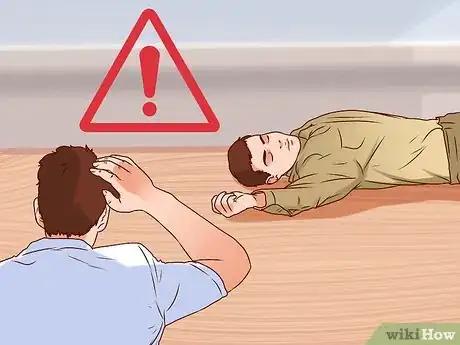



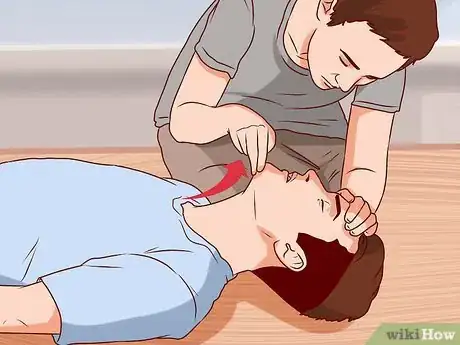




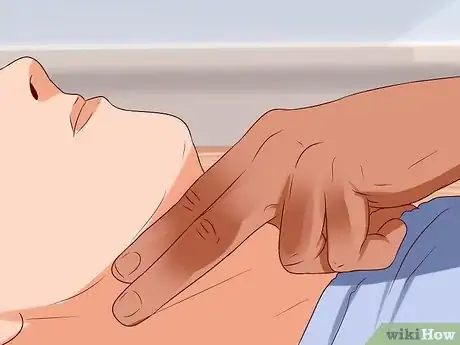


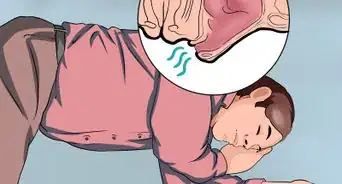

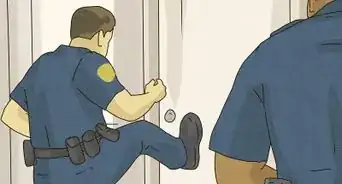



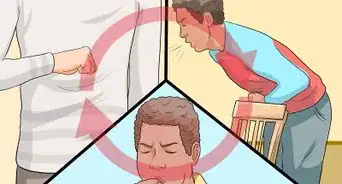














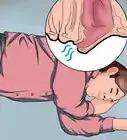

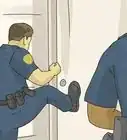




































Medical Disclaimer
The content of this article is not intended to be a substitute for professional medical advice, examination, diagnosis, or treatment. You should always contact your doctor or other qualified healthcare professional before starting, changing, or stopping any kind of health treatment.
Read More...